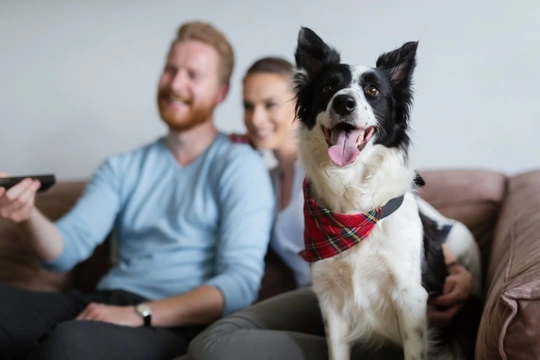
Does your dog like to watch the television? What do dogs see when they watch TV?
The first time a puppy or even an adult dog sees a television can be quite funny to witness, particularly if there are dogs barking on the soundtrack too! Many dogs will sit enthralled watching people, dogs, and activity on the TV, and even make quite a fuss about looking behind the TV set to see where these mysterious other animals are hiding out.
When dogs and puppies get used to the presence of the TV, many of them seem to essentially tune it out and stop paying attention to it – but some dogs will sit and actively watch and listen to TV shows quite happily, and will often like to have the TV left on for them when you go out too.
If your dog likes to watch TV, seems to react particularly to certain things happening on the screen or is generally interested in what is going on, you might have wondered why this is – and what dogs actually see when they view your TV.
In this article we will look at why some dogs like to watch TV, what they see when they do it, and talk about special TV programmes that are designed especially for canine viewers! Read on to learn more.
What do dogs see and hear when they watch TV?
The way that dogs see the world is rather different to that of humans, and so what they see when they watch TV is different to the image that we see as well.
Humans have trichromatic vision, which means that we see more colours than dogs do – we have three colour receptors in our eyes that allow us to see shades in the green, red, and blue spectrum, giving us a lot of colour acuity and the ability to see shades that dogs simply can’t.
Dogs have dichromatic vision, and just two colour receptors – which pick up blue and yellow. This means that shades of red and green are lost on your dog – so they would not be able to pick out a red ball on green grass by colour, either on TV or in real life.
This means that a lot of the detail and shading we as humans see on TV is lost on your dog, but images and scenes with a lot of contrasting blue and yellow shades will stand out to your dog much more clearly than other shades.
Additionally, dogs’ eyes are better able to pick up movement than static objects, and so they are more likely to watch action scenes and activity than slow shows!
Dogs’ eyes are actually able to register changing and moving images faster than our own eyes, which means that HD television and very crisp, clear images are easier for them to see than lower resolution screens – and older, analogue-style televisions that move at a much slower frame rate than modern sets will actually appear to be flickering in your dog’s sight.
When it comes to the sounds that come from the TV, your dog can hear pretty much everything that you can, and maybe more – dogs have the ability to hear sounds of a much higher frequency than humans can, and so sometimes, they might pick up on sounds from the TV that us humans miss entirely.
How do dogs perceive the television?
As to what dogs think of the television, well, the whole concept of TV is understandably pretty hard for them to get to grips with. Dogs who aren’t used to TV will often pace and look around it trying to find the source of the noise and movement, and the chances are that they don’t really understand what it is, or what is going on.
Soundtracks that are designed to generate suspense or anticipation will likely have a similar effect on your dog, although peril, danger and violence don’t seem to be read literally by dogs when on TV, although some dogs do get quite worked up when there’s a lot going on on the screen.
Why do some dogs like to watch TV?
Some dogs enjoy watching TV either on a regular basis, or when a certain type of show or soundtrack is playing. The chances are that something catches their attention, like a particular colour contrast, sound, or movement, and they find it interesting to watch it.
Additionally, most dogs watch TV with their families, and will feel secure, comfortable and loved when doing so – which helps to build up positive associations in your dog’s mind with the TV meaning family time, and the chance to chill out with their favourite people.
Dog breeds that have the most acute scenting abilities like the beagle and the bloodhound are less likely to be interested in TV than other breeds, because their sense of sight is so much less important to them than their scenting ability. However, sighthounds and herding dogs like the greyhound and Border collie that are highly attuned to movement are those most likely to enjoy watching TV!
TV shows and channels just for dogs
Did you know that there is actually a TV channel designed specifically for dogs? It’s called DogTV, and is designed to appeal to dogs rather than people. The channel has a faster frame rate than normal shows to take into account dogs’ ability to view movement faster than we can, and it is designed to show a lot of imagery in colour contrasts that dogs can perceive.
Back in 2012, Baker’s dog food produced a television advert for their food that was designed specifically to generate a response from dogs too, incorporating high-frequency sounds that dogs can hear, and using bold, contrasting colours with a bluish tint to the screen. The ad was shown in the UK, so you might remember it – and your dog’s reactions to it at the time!



